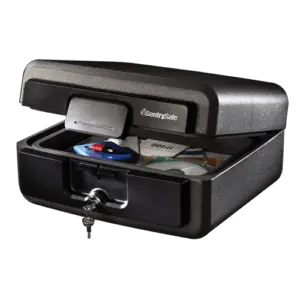When it comes to choosing a safe, for home or work, the question is: should I buy a fireproof safe? But, why buying a fireproof safe if they aren’t effective? This is why I researched that subject: I wanted to know if I could trust all the recommendations the safe makers give us when they advise their safes. I wanted to know if they specifications translated in real-world scenarios. I wanted to know if fireproof safes reacted well, as intended, in the case of a fire. This is all this that I am sharing with you today.
Are fireproof safes effective? Fireproof safes are only effective within a time frame. Each safe is rated for a duration in which it can resist the heat: UL (30 minutes | 1550 °F), UL1 (60 minutes | 1700 °F), etc. A safe stores papers, electronics, jewelry that suffers high temperatures. That is why a good fire safe can save the day. You can even add a fireproof box inside your safe for additional security. And an intumescent seal acts as a protection against fire extinguisher powder and water.
A fire happens very fast. If you want to protect your valuables, your safe has to be a good one, but how? Can we trust any safe said to be fireproof?
Are fireproof safes really fireproof?
I did a lot of research and detailed how fire safes are made in this blog post. Go ahead, it is a good read to understand if you should buy one. But in a nutshell, the main difference between a regular safe and a fire-resistant one is the additional layer of insulation between the sheets of steel. The door itself has a bigger layer of insulation or two, to protect the lock. On the good quality safes, there is an intumescent seal around the door. That seal inflates when the heat rises.
- Is a safe really fireproof?
There is no such thing as a fireproof safe per se. A waterproof object can be perfectly sealed against water, indefinitely. But what is true for water is not true in the case of a fire. In the event of a fire, there are fumes and heat. And then, water and powder from a fire extinguisher.
So if a safe is not fireproof, it is because it is a matter of time. The safe can resist heat as long as it has been constructed and rated to. The better the safe, the longer it can withstand a fire. For example, here is the table of the main specifications:
| Rating | Minutes | Temperature |
|---|---|---|
| UL | 30 minutes | 1550 °F |
| UL1 | 60 minutes | 1700 °F |
| UL2 | 2 hours | 1850 °F |
| UL4 | 4 hours | 2000 °F |
That is why the material used is called fire-retardant. But a fireman told me how heat and fumes can be dangerous, and not only flames. Heat because of spontaneous combustion, and fumes because they are toxic gases.
- Autoignition
Fumes can deteriorate paper, fabric or electronics. And heat, when high enough, can start a fire without a spark or a flame. That is to say, if the heat arises, the content of a safe can burn with spontaneous combustion. All your valuable documents can burn even if there aren’t any flames around the safe!
Here are spontaneous combustion temperatures for a given substance. Some temperatures can be quite low, even if there isn’t any heat runaway (source).
| Substance | Autoignition |
|---|---|
| Paper | 218–246 °C (424–475 °F) |
| Leather / Parchment | 200–212 °C (392–414 °F) |
| Wood | 450 °F gradually chars |
| Wood | 700 °F burns |
| Cardboard | 450 °F |
| Plastic | 100 °F starts to melt |
| Plastic | 450 °F burns |
| Gasoline | 247–280 °C (477–536 °F) |
We can see that what is usually stored in a safe burns in a quiet “low” temperature. Papers, leather, cardboard, plastic, electronics: all those things are in a safe. I think it is clear that a fireproof safe is the way to go when you choose a safe to store all the above.
A UL1 safe that is rated to withstand 1700 °F for 60 minutes can protect your papers, and even electronics, for that period of time. Let alone UL4 type safes.
When a fire-resistant safe withstands the temperature for a given time, you maximize your chances of getting back your valuables in a good or acceptable condition. In that sense, I think we can say the answer is yes, a fireproof safe is effective. But there are a couple of caveats:
- it has to be of a good made,
- it has to have an additional intumescent seal,
- it has to be a good safe all-around with a good lock.
You can even maximize your chances by choosing to install the safe in a place less prone to heat in the case of a fire:
- in the cellar,
- in the corner of a downstairs room,
- avoid the upstairs room.
Are any fireproof safes waterproof and airtight?
The answer is no. But how fire safes can withstand fire extinguisher powder and water, you may ask? And hot air?
Most cheap fireproof safes don’t even have a seal. Those should be avoided at all cost. They don’t provide sufficient insulation.
But good safes with a seal: some safes have a rubber seal that acts as a kind of insulation. It is better than nothing but is not technically airtight or waterproof. But a rubber seal can provide some protection against humidity for a while. But humidity will eventually find its way in.
Some safes don’t have a rubber seal, because it is more convenient in the day to day use of the safe. It has nothing to do with the certification.
The intumescent seal expands with heat when a fire occurs. Then and only then does it provide airtight characteristics to the door and waterproof to the safe. The content is then protected against water, heat, and powder. That seal is necessary to the certification as it keeps the temperature inside the safe as low as possible by not allowing air in.
That is to say: an intumescent seal serves no purpose in a day to day use: it doesn’t prevent humidity in. So a fireproof safe is airtight and waterproof only during the fire; otherwise, it is not.
After the fire, the seal has to be replaced, of course. It is a single use seal. But I doubt replacing the seal will be your main preoccupation after a fire. And if you can get back the content of your safe, the insurance will have you covered anyhow.
You have to choose a safe designed to be waterproof. Any fire safe is not.
Most common fire safes are airtight and watertight only during the fire as the intumescent seal expands, otherwise, they are not. You have to choose some special waterproof safes to be protected against floods.
I have gathered a lot of information on waterproof safes that I have consolidated in this post. Data on floods in America might surprise you.
If I already have a regular safe, do I need to buy a new safe?
No, you do not need to replace your safe if you only have to protect some documents or electronic devices.
If you have a good safe that is big enough, you can upgrade it with various fireproof documents bags or fireproof and waterproof boxes of different sizes.

This is the handiest upgrade, as it will give you the convenience and peace of mind of a fireproof safe with less money than reinvesting in a new safe. If you like to be extra careful, you can even install one of those boxes as an additional layer of security in a fire safe.
If you add a fire-resistant bag inside the safe, it will provide additional security for your most important belongings. This one on Amazon is quite cheap for some documents; this box from Sentry provides an airtight and watertight capability for many documents (0.65 cubic feet) and is on a budget as well.
A fireproof safe has to be a safe in the first place
But always remember: a safe has to be of good quality anyhow. Some fire safes look sturdy because they are big, but they offer a weak lock with small bolts. The lock can be easily drilled or lock picked. The bolts are not resistant enough to intrusion. The sheets of steel that form the carcass are too thin and can be easily cut. That is why, I only recommend buying a good safe that is fireproof, and not any fireproof safe. If you hesitate, first check the weight of the safe. If it is too light, there is a problem of steel thickness and bolts size. If you ever found your safe cracked open or stolen, you might understand that the primary risk is theft, long before fire or floods. So choose a good overall safe.
Are fireproof safes toxic?
No, for several reasons.
- The fire retardant material is held between the sheets of steel that are welded. There is no air flow between this material and the outside of the safe.
- This material consists of mineral wool, calcium or sodium silicate, fire protected concrete. All those are not toxic.
- Perlite or vermiculite was also used, although less often, and almost no more today. Perlite exists naturally in silicous rocks and is not toxic. It should not be ingested though. Vermiculite is a hydrous phyllosilicate mineral. It expands dramatically when heated (as perlite) which gives its volume and light structure. It is commonly used in gardening. It shouldn’t be inhaled, that is why the only danger might be cutting the safe open through its structure which a disk cutter, and without respiratory protection (a protective respirator mask).
So, to be fire-resistant, a safe is sealed as much as possible. The walls containing the fire retardant material are welded. That is why we can say that a fire safe is not toxic.

